|
|
Period:
First World War
Region:
Austro-Hungary
Austro-Hungarian camp in Boldogasszony
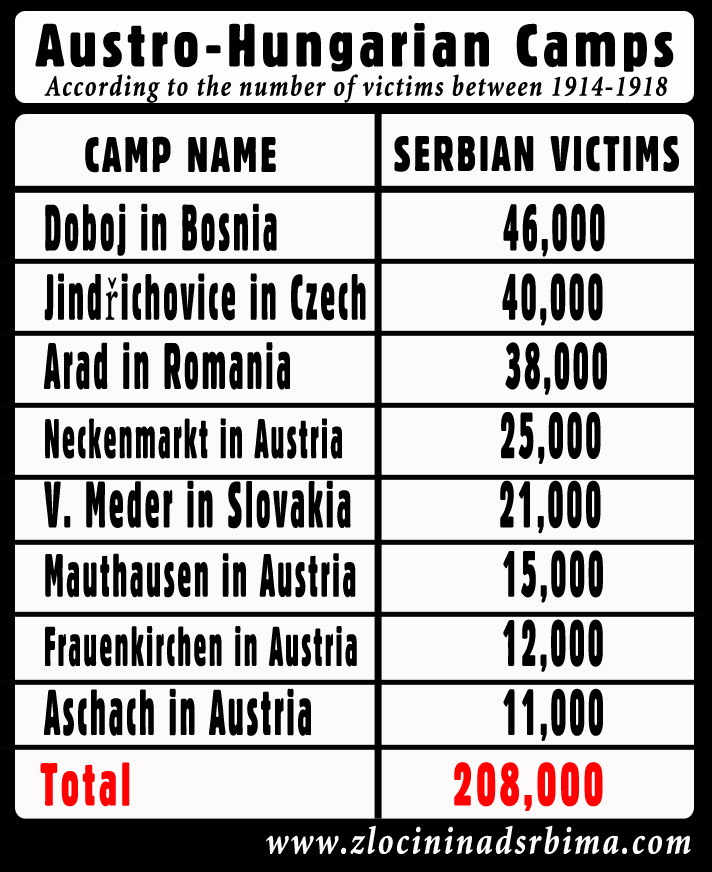 Boldogasszony concentration camp (Hung. Boldogasszony; Germ. Frauenkirchen), was one of many in the system of camps established within the Austro-Hungarian Empire, with the intent of genocide and eradication of Serbian populous during the World War I. Boldogasszony concentration camp (Hung. Boldogasszony; Germ. Frauenkirchen), was one of many in the system of camps established within the Austro-Hungarian Empire, with the intent of genocide and eradication of Serbian populous during the World War I.
This house of terror was located some 70 km southeast of Vienna (the capital city at the time), on the lake Neusiedl's rim, near the little town of Frauenkirchen in today's Austria.
The camp was established in February 1915. and operated until the end of October 1918. The Imperial Court, the Governments, the Parliaments (all the top authorities) of the Habsburg Monarchy were familiar with its existence.
According to some estimates, approximately 25,000 prisoners went through it, the majority of whom were the Serbs. Up to 10,000 Serbs had been either killed here or died as a consequence of hunger, disease or torture. Prisoners were of all age groups and of both genders. Even children as young as 16 were brought to the camp.
To commemorate the great suffering of Serbian people during the First World War, a monument and a marble cross have been erected, where the camp used to be located.
|
FIRST WORLD WAR 1914-1918 |
|
Battles of: Cer, Drina, Kolubara, Leget, Cemerno, Mojkovac, Kajmakcalan, Gornicevo, Dobro Polje
Camps: Mauthausen, Arad, Jindrihovice, Broumov, Boldogasonj, Nadjimer, Nezider, Aschah, Doboj, Sliven
Crimes: Macva, Surdulica, Great Retreat, Sabac
|
BACKGROUND
At the beginning of 1904, the Kingdom of Serbia signed a trade agreement with the USA, France and Russia... and began exporting its products to the overseas countries through the port of Thessaloniki.
This led to a great economic upswing of the Kingdom of Serbia, which annoyed the Vienna Court, which viewed Serbia as a great rival since Serbia had the highest economic growth rate in Europe at the time, and at the same time a large number of Serbs lived in the occupied territories of the Habsburg Monarchy.

Map of south-eastern Europe in November 1913.
The army of the Kingdom of Serbia liberated its enslaved territories (Raska, Kosovo and Metohija and Old Serbia) from the Turks in the First Balkan War, by achieving major victories in the fall of 1912 at the command of Duke Petar Bojovic at Kumanovo, Prilep and Bitola, and as such completely expelled the Ottomans from the Balkans.
And a year later in the summer of 1913 the army of the Kingdom of Serbia protected Vardar Macedonia from the Bulgarians in the Second Balkan War. The Serbian national revolution was thus continued, at the beginning of the 19th century by Karadjordje Petrovic and Milos Obrenovic.
In the summer of 1914, the Austro-Hungarian Monarchy used the Sarajevo assassination, that is, the assassination of Austrian Crown Prince Franz Ferdinand by members of Young Bosnia (Gavrilo Princip, Bogdan Zerajic, etc.) as an excuse to invade the Kingdom of Serbia, thus starting First World War.
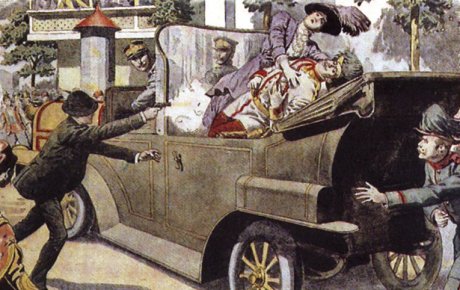
Gavrilo Princip and his comrades in Sarajevo
A dispatch was sent from Vienna, which no sovereign state could accept. Thus, in late July 1914, Austria-Hungary declared war on Serbia. Montenegrin King Nikola I Petrovic and Russian Emperor Nikolai II Romanov immediately sent messages saying that they would help the Serbs. Likewise, German Emperor William II made a military alliance with the Vienna Palace.
CAMP INCEPTION
During WW1, a small town of Boldogasszony belonged to the Hungarian (German-West Hungary) territory, hence the Hungarian name of it. Once the Habsburg Empire came to an end, the little town became part of today's Austria.
Boldogasszony concentration camp was established in February 1915. As the WW1 was accelerating, so was the need for more space where to keep the POW. This was due to the fact that the existing camps in Nagymegyer, Nézsider, Arad and others, were already overflowing with inmates.
The official name of this death machine was "The Imperial and Royal Prisoner of War Camp Nagymegyer" (Kaiserliches und Königliches Kriegsgefangenenlager Boldogasszony) and it was located on the east bank of the Neusiedl lake.
Imperial court in Vienna, Royal court in Budapest, the Austria-Hungary parliament and government were aware of the camp's existence and its on-goings, as the sole purpose of their existence was destruction and annihilation of Serbian people.
Serbian prisoners were collected and brought from the Šumadija region (SR), Drina Valley (BIH), Posavina (Sava river basin), Raška district (SR), and later from Montenegro after its capitulation in January 1916.
CAMP CONDITIONS
Boldogasszony concentration camp was profuse in its cruel conditions, amongst other, due to its proximity to the swamp terrain. Many interns suffered mosquito and other insect bites, especially in the summer seasons.
Also, its proximity to the mountain range of the Alps, had many interns dying during winter times, due to the low temperature exposure.
The consequence of lack in decent medical care, no proper hygiene allowance and poor food ratios for the inmates were many diseases, such as dysentery.
As in other camps, here too, the prisoners were used in heavy labor, and even the slightest disobedience was heavily penalized.
Serbian prisoners were treated as worthless in this camp, evidenced by the camp logging. In it, 157 pages of inmates records show Serbs being logged as simply "unknown" or 'Serb".
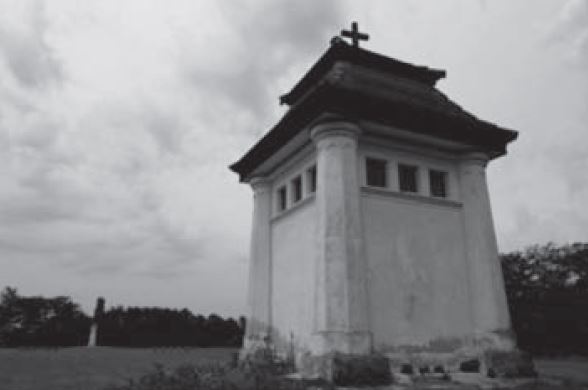
TESTIMONIES
As many personal letters show, prisoners were suffering from bouts of guilt and shame from finding themselves in this situation, besides the unsustainable, deadly imprisonment conditions. Letters were retained by the guards and only lately were discovered and published.
This is what a Serbian inmate wrote to his brother:
- "I haven't been writing to you until now. For I see the fact of where I'm at imprisoned, as humiliating and shameful, but what can I do now, such was my military destiny. They caught me by deceit, during Vranovo (SR) withdrawal. I had no other choice but to raise my hands in the air, to my shame and yours, for the real warrior never allows himself to be caught alive by his enemies...
I will do my best to get this shame washed off the Petrović family name if I survive these wires. Send my best wishes to our brave horsemen, noblemen...".
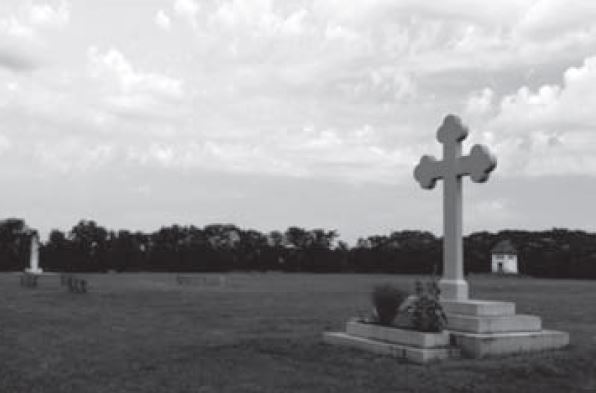
CAMP CLOSURE
Boldogasszony concentration camp was closed on 29th of October, 1918., just few days ahead of the Imperial Habsburg monarchy's Government collapse.
Estimated 25,000 prisoners went through it. They were mostly Serbs, followed by Russians and Italians.
Upon the camp's closure, surviving Serbian interns made their move by railway wagons towards their homeland, towards their loved ones.
YEARS LATER
Later on, during the WW2, upon Hitler's occupation of Austria, Nazi authorities established the concentration camp for the Jews, in the exact same location.
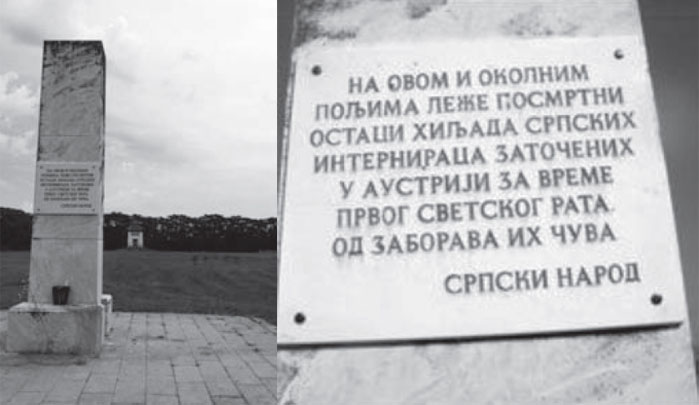
In the location of the camp in Boldogasszony, in the Frauenkirchen prisoner of war cemetery, erected was a "Serbian Cross" and close by the monument as well. On the marble plaque of the monument, the following words are engraved:
"IN THIS AND SURROUNDING FIELDS LAY THE REMAINS
OF THOUSANDS OF SERBIAN INTERNS IMPRISONED IN AUSTRIA
DURING THE FIRST WORLD WAR FROM OBLIVION SAFEGUARDED
BY THE SERBIAN PEOPLE"
Nowadays, every year members of The Association of Serbs in Austria (Serbische Gemeinschaft in Österreich) visit the memorial on remembrance dates pertaining to WW1, commemorating the fallen.
Tags:
Please, vote for this article:
Visited: 4867 point
Number of votes: 35
|